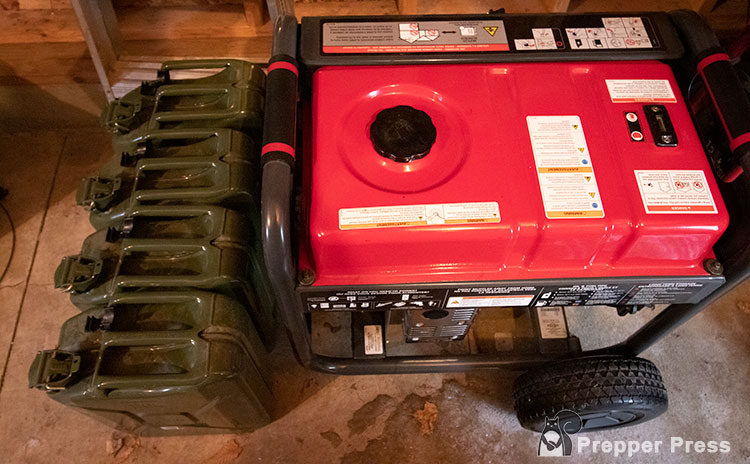
Gas shortages can happen at any moment, whether by natural disaster or a ransomware hack attack on pipelines. This is why it’s critical that preppers know how to store gas.
Maybe you want to make sure the gas you use for small engines stays good over the winter. Maybe you want fuel on-hand in case a massive storm rolls in killing power and you’ll want to run your generator to keep the refrigerator running. Or maybe you’re just stocking fuel for the pending zombie apocalypse – it could happen!
Whatever the reason, storing gas is difficult because it quickly starts to break down. According to Exxon, gas should be used within a month of purchase.
So, having quality gas on-hand means cycling through the gas every 30-days… unless you take the right steps to storing it!
Follow my 6 easy steps to proper, long-term gas storage and you will know how to store gas. You can have gas that is of good quality for at least two years.
Rather watch a video than read a post? Here’s the video version of this article:
Table of Contents
How to Store Gas
Storing gas isn’t rocket science, but it does require a bit of know-how.
1 – Store Gas in a Quality Fuel Can
Maybe you’re a power prepper and want to store gas in large 275 gallon tanks, but odds are, for most of us, storing gas means using standard 5-gallon gas cans, whether it’s the typical red plastic can or a steel jerry can.
Plastic gas cans are far more common, and that’s for good reason – they’re far more affordable. But does that make them better? Let’s take a look…
What is Better – Plastic or Metal Gas Cans?
Each container type, like anything, has its unique set of advantages and disadvantages. For metal gas can comparison, I’m going to compare the standard 5-gallon plastic can to the prepper-coveted 20 liter Jerry can.
When it comes to quality, metal gas cans are superior. Plastic cans may be better for you, however.
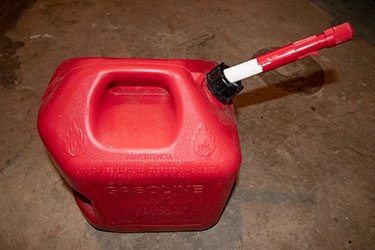
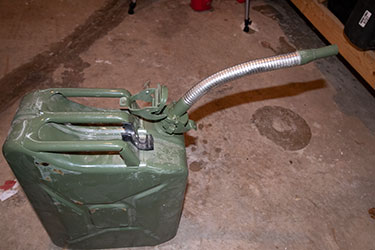
Advantages to Plastic
There are 4 main advantages to plastic gas cans:
- Price – You can buy a plastic can for much less than a Wavian NATO Jerry can.
- They won’t rust.
- In a fire, plastic cans melt. Metal cans explode.
- They are plentiful. You will find them online, at Wal-Mart, the local hardware store – everywhere.
Advantages to Jerry Cans
The Jerry can was invented by the Germans in the 1930s. “Jerry” was slang for German, so the cans became known as “Jerry cans” by the Allies in World War II. The Allies liked these steel cans so much that they too began using them, to the point that President Roosevelt said,
Without these cans it would have been impossible for our armies to cut their way across France at a lightning pace which exceeded the German Blitzkrieg of 1940.
https://danishfuel.com/the-can-that-won-the-war/
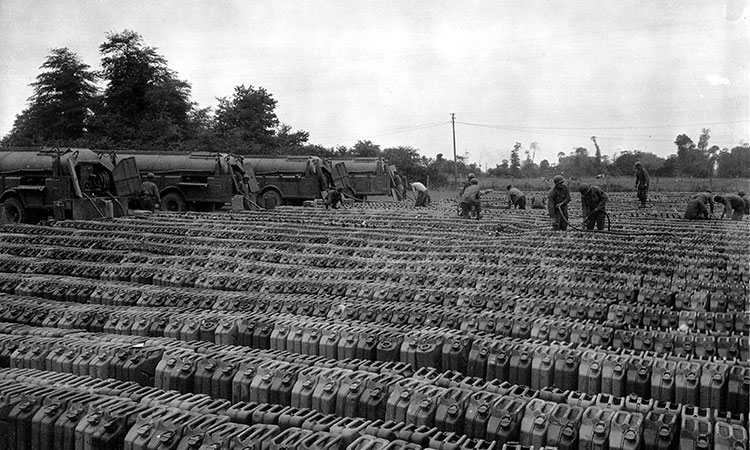
From my view, there are 8 distinct advantages that the steel Jerry can has over the plastic can:
- They’re rugged. (If you don’t buy a cheap Chinese knock-off.)
- They have superb carry handles designed in such a way that they can be carried by one soldier or two.
- The cover seals tightly and locks into place.
- They stack much more tightly, so you can store gas in less space.
- They hold 20 liters, which gives you an extra .3 gallons over a 5-gallon container.
- Fuel leaches into plastic over long periods of time, not with steel.
- Plastic cans expand and contract with temperature changes, eventually warping out of shape. Steel does not.
- Jerry cans have great spouts. Plastic containers come with god awful safety spouts designed to stop spills, which in reality, cause nothing but headaches. Jerry can spouts are long, bendable, and have zero safety features. Gas just flows out!
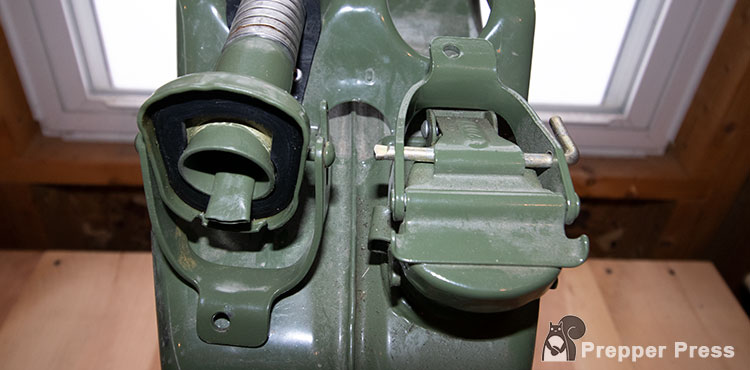
I had a wholesale account with Wavian when I bought mine. Getting them at wholesale discount took the sting out of the price, but even at retail cost I highly recommend one (or two or twelve). Buy Wavian if you do. They’re the real deal, rugged, and featured in many post-apocalyptic movies like Mad Max.
2 – Store Gas in a Proper Location
Now that you have a proper storage container, you need to store the container properly.
Keep gas under cover, out of the sun, and away from heat sources. If possible, keep it away from fluctuating temperatures, but never store it in your home. Make sure your can has a tight seal. Gas vapors are heavier than air, so if vapors leak, they will travel along the floor… and if they find an ignition source… *kabloom*
3 – Keep Your Gas Cans 95% Full
Moisture condenses along the walls of the can, which then adds water to your fuel. If there’s too much water you’ll get reduced performance and a shorter shelf life. If the gas can is 95% full, there is less room for condensation to happen. For that matter, when you’re done using a small engine, fill the engine’s tank 95% full for the same reason.
Why not all the way? Because as temperatures vary, fumes expand and contract. Leaving a small amount of space allows room for that.
4 – Add Fuel Stabilizer
Fuel stabilizer is will greatly extend the storage life of your gasoline. It’s one of the most important steps yhou can take in our methods on how to store gas.
You can buy fuel stabilizer most anywhere (like right here). There are different types (one that treats the air as well, for example), so find the one that you like.
I add stabilizer to the gas can before I fill it. Pouring gas down on the stabilizer, I theorize, mixes the two so I don’t have to shake the can after the fact.
Now, if you’re using fuel stabilizer for the first time and you have untreated gas in the engine, run that engine long enough for the old gas to burn off and the treated gas to get into the system. You don’t want untreated gas left in the lines of your engine unless that engine is getting regular use.
5 – Buy Ethanol-Free Gas
This is a big one, just as important as using fuel stabilizer. In fact, these two steps (fuel stabilizer and ethanol-free gas) form the crux of our 6 steps on how to store gas.
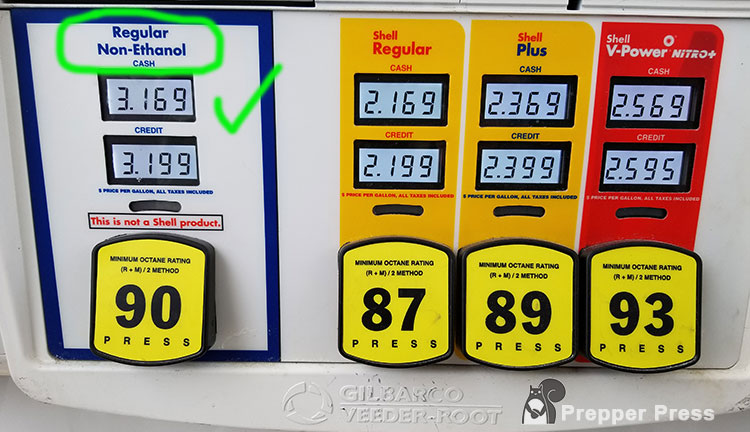
The problem with today’s gasoline is the ethanol. Refiners add ethanol to comply with the 1990 Clean Air Act (it burns cleaner). Most gas in the U.S. is now 10% ethanol.
The first problem with ethanol is that it has about 33% less energy than pure gasoline. The second problem is that it absorbs moisture from the air. Water then gets drawn into the engine causing a chemical mix that leads to corrosion, stalling, and trouble starting the engine.
The reason you don’t run into this problem with your vehicle is because you’re cycling through the gas a lot faster. It doesn’t sit long enough to cause problems.
What’s more, ethanol acts as a solvent in small engines. It can dissolve old gum and varnish deposits that then clog the carburetor. When this happens, your small engine isn’t going to start until that carburetor is taken apart and cleaned. (See my earlier note on cycling out untreated gas out of the lines.)
Can You Still Buy Ethanol-Free Gas?
You can buy ethanol-free gas. Small cans of it are sold at places that carry small engine equipment (or right here), but doing it that way is expensive. There is a more economical approach – if you know where to look.
Pure-gas.org is a website that tracks the locations of ethanol-free gas. You can go there and find a location near you. I found a station somewhat nearby, and I wasn’t the only one with this idea as I saw many people come to fill cans. They charged $1.00 more per gallon. Compare that price to buying it in small cans!
The picture below, taken a while ago, shows a nearby gas station making a point to advertise their ethanol-free gas option. People, like myself, will make a special trip to the gas station just to stock up on this fuel. This is particularly true for people that use a lot of small engines, lawn care businesses, etc.
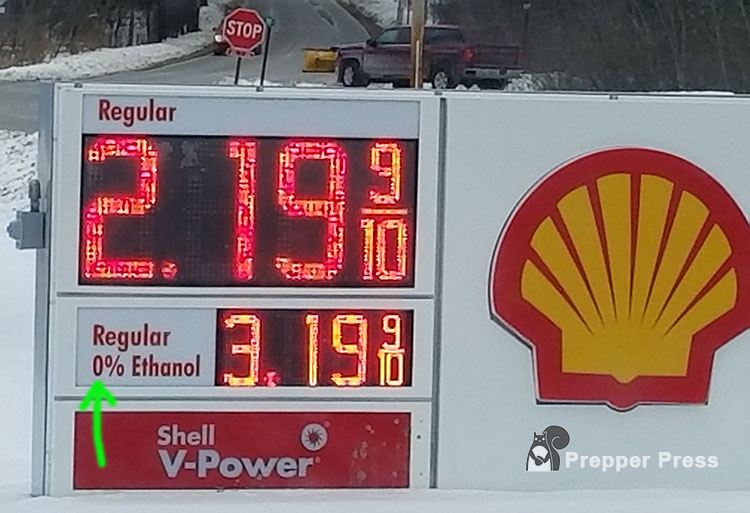
This picture below was taken at a small airport. Not many people realize it, but you can also go to your local airport and pay for ethanol-free gas. What you are buying here is aviation gas, and you will pay more for it because it’s 100 octane. Some people swear by using 100 octane for small engines, others claim it runs too hot.
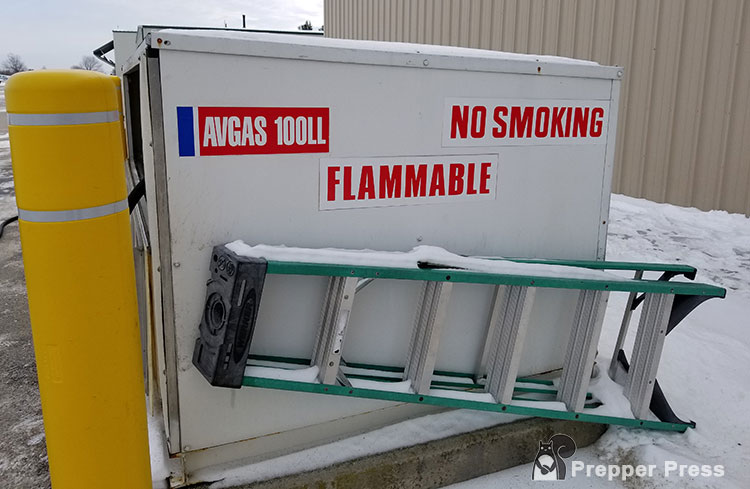
For storage purposes, and everyday small engine purposes, this is well worth the price!
#6 – Label It and Rotate Stock
Just like with long-term ammo storage, it’s important to rotate stock. Label your gas cans with the purchase date, octane level, and whether it is ethanol-free or not. That way you are always getting the oldest out first.
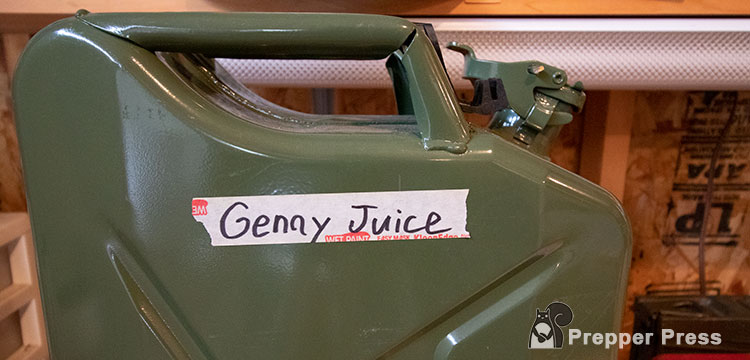
You don’t want to run 100LL AvGas in your vehicle, so if you do buy it, make sure to label the can so it doesn’t get mixed up.
Wrap Up
Follow these 6 steps on how to store gas and you’ll still be riding your Mad Max war rig in the wasteland well after every other vehicle has stalled out. You’ll be able to weather inclement weather and any other disruptions to the fuel supply chain… at least for a while…

3 comments
Goi advice. Keeping tanks ar 95% is not a bad idea. But it’s debatable whether water condensation forms in a sealed container of gas. Hard to prove either way.
When I fill Jerry cans to 95%, find I have a lot problems opening the can without have gasoline blast out at me, spraying all over the place. If it gets colder, this is not an issue, as the cans acutally form a vacuum and pull air in when opened. But if it’s gotten warmer outside, then the air in the highest point of the can forms a high pressure pocket. When the can is opened, that pocket of pressure blows down through the fuel in the lower part of the can and sprays the gas out of opening. leaving enough empty space in the can allows that air to just blow down and out the opening without carrying any gas with it. I know it’s a lot more satisfying to fill these up high and feel like you are getting every available bit of possible fuel storage out of them, but if you are going to ever used them in warm weather, it’s just not worth the fuel waste and the mess it makes.
Good feedback – thanks.